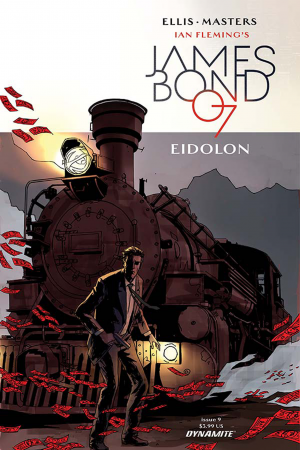Review: James Bond #9
When Umberto Eco wrote his final novel Numero Zero, he told a story about conspiracy. In his case, it was a conspiracy surrounding the history of Italy—that Mussolini never died but was secreted away and awaiting the day for a secret fascist army to rise up and place him back into power. Within the same year of that novel’s release, a superhero movie told a similar story—one where a supposedly defunct Nazi organization infiltrated the government of the United States and edged the country towards fascism and instability, a little movie called Captain America: Winter Soldier. The infiltration conspiracy has always been an attractive one. Where the villains of history, the bad guys we know and understand, can be blamed for every poor decision our countries’ governments and cultures make. The Illuminati, the lizard people—both explanations and diversions from the naturally chaotic and politically oppressive state in which the world functions.
Only Eco’s conspiracy was operating underneath something very real—a Cold War rumor that became a reality. Operation Gladio was a NATO-led campaign following the end of World War II that placed a stay-behind army in Italy either in the case of an invasion from the Soviet Union or a political rise in communism within the country.
 Stay-behind armies are a paranoia-inducing notion, one where a foreign country’s army doesn’t leave but rather secretly become civilians within that country, trained and waiting for their call to arms.
Stay-behind armies are a paranoia-inducing notion, one where a foreign country’s army doesn’t leave but rather secretly become civilians within that country, trained and waiting for their call to arms.
Warren Ellis’ current run on James Bond is a story where the rumors and myths of the Cold War haunt the present like specters or a dormant disease.
The revelation last issue that a stay-behind army infiltrated both the MI-5 and the CIA has made James Bond’s return to the United Kingdom less of a welcome home than a new, political battlefield.
In the first issue of this series Ellis introduced a new law passing through the government—one that would keep all British agencies disarmed while on British soil. What could have been a simple reflection of England’s modern gun politics now has a much more sinister tone as MI-6 is left to question if it’s a deliberate attempt to weaken them.
The political espionage paranoia permeates this tension throughout the issue as the first half is turned into a stand-off without any guns. A simple visit from an MI-5 agent with reasonable questions about an assassination attempt on a British citizen has everyone tensely itching for their weapons.
This tension built over the first twelve pages finds its release as the second half turns into a fun action sequence explosion with a gunfight in a train yard. Yet at the same time, this is where the issue also reveals its weaknesses. This story arc, Eidolon, even more so than the last reads like a broken up movie. So when the action sequence finally ends there’s no new revelation, nothing in the issue’s pace that brings me down from the visceral high of the sequence. This creates a tonal dissonance that would be fixed if I was reading a trade collection where I could move forward but here I’m only left with a pit in my stomach that never settles.
This is a symptom of an endemic trend across comic books as they write for long-form stories in a market that publish only in short-form. A trend that frustrated me so much that it stopped me reading single issues altogether for a long time.
Yet this is a Warren Ellis story and what might bother me more in other stories, is soothed over with the little ticks that bring me to his writings in the first place. He’s a tour guide for the weird sciences and forgotten histories of England. A traditional Bond movie might take Bond across a stumbling of beautiful vistas and happenstances that bring him to the villain. Eidolon instead finishes a hook left at the start of this arc.
The suspicious money being moved in issue seven is decrypted and revealed to loop back into England’s “Strategic Reserve Fleet”, a Cold War rumor here turned to reality. The British government during the Cold War expected that, in the event of World War III, nuclear bombs would completely wipe out their electric train lines and in preparation kept a reserve of steam engines underground to reform their lost infrastructure.
There’s a reason James Bond and the espionage genre broke out during the Cold War. There was so much paranoia, so many strange secret operations that we needed characters able navigate and make sense of the uneasiness. In our post-9/11 surveillance and internet age, we wrestle with an ever-present but very different brand of paranoia—one less on the level of nations as it is about a person’s individual privacy.
There have yet to be any standout characters that represent an answer to this reality and despite flirting with it; this series has yet to transform James Bond into that character. Instead, this is a fusion where James Bond can exist in the present while still married to his Cold War roots, letting him be a savage instrument in a more sophisticated era.
[su_box title="Score: 3/5" style="glass" box_color="#8955ab" radius="6"]
James Bond #9 Writer: Warren Ellis Artist: Jason Masters Publisher: Dynamite Entertainment Price: $3.99 Format: Ongoing; Print/Digital
[/su_box]